
Mathemagics Workbook
.pdfWHY THESE TRICKS WORK
This section is presented for teachers, students, math buffs, and anyone curious as to why our methods work. Some people may find the theory as interesting as the application. Fortunately, you need not understand why our methods work in order to understand how to apply them. All magic tricks have a rational explanation behind them, and mathemagic tricks are no different. It is here that the mathemagician reveals his deepest secrets!
In this chapter on multiplication problems, the distributive law is what allows us to break down problems into their component parts. The distributive law states that for any numbers a, b, and c:
(b + c) x a = (b x a) + (c x a)
That is, the outside term, a, is distributed, or separately applied, to each of the inside terms, b and c. For example, in our first mental multiplication problem of 42 x 7, we arrived at the answer by treating 42 as 40 + 2, then distributing the 7 as follows:
42 x 7 = (40 + 2) x 7 = (40 x 7) + (2 x 7) = 280 + 14 = 294
You may wonder why the distributive law works in the first place. To understand it intuitively, imagine having 7 bags, each containing 42 coins, 40 of which arc gold and 2 of which are silver. How many coins do you have altogether? There are two ways to arrive at the answer. In the first place, by the very definition of multiplication, there are 42 x 7 coins. On the other hand, there are 40 x 7 gold coins and 2 x 7 silver coins. Hence, we have (40 x 7) + (2 x 7) coins altogether. By answering our question two ways, we have 42 x 7 = (40 x 7) + (2 x 7). Notice that the numbers 7, 40, and 2 could be replaced by any numbers (a, b, or c) and the same logic would apply. That's why the distributive law works!
Using similar reasoning with gold, silver, and platinum coins we can derive:
(b + c + d)x a = (bxa) + (c x a) + (d x a)
Hence, to do the problem 326 x 7, we break up 326 as 300 + 20 + 6, then distribute the 7, as follows: 326 x 7 = (300 + 20 + 6) x 7 = (300 x 7) + (20 x 7) + (6 x 7), which we then add up to get our answer.
As for squaring, the following algebra justifies my method. For any numbers A
and d
A2=(A + d) x (A - d) + d2
Here, A is the number being squared; d can be any number, but I choose it to be the distance from A and the nearest multiple of 10. Hence, for (77), I set d = 3 and our formula tells us, 772= (77 + 3) x (77 - 3) + 32 = (80 x 74) + 9 = 5929.
32
The following algebraic relationship also works to explain my squaring method:
(z + d) = z2 + 2zd + d2 = z(z + 2d) + d2
Hence, to square 41, we set z = 40 and d = 1 to get:
(41)2 = (40 + 1)2 = 40 x (40 + 2) + 12= 1681
Similarly,
(z-d)2 = z(z-2d) + d2
To find if when z = 80 and d = 3,
(77)2 = (80 - 3)2 = 80 x (80 - 6) + 32 = 80 x 74 + 9 = 5929
33

CHAPTER 4
MENTAL DIVISION
Mental division is a particularly handy skill to have, both in business and in daily life. How many times a week are you confronted with situations that call on you to divide things up evenly, such as a check at a restaurant? This same skill comes in handy when you want to figure out the cost per unit of a case of dog food on sale, or to split the pot in poker, or to figure out how many gallons of gas you can buy with a $20 bill. The ability to divide in your head can save you the inconvenience of having to pull out a calculator every time you need to compute something.
With mental division, the left-to-right method of calculation comes into its own. This is the same method we all learned in school, so you will be doing what comes naturally. I remember as a kid thinking that this left-to-right method of division is the way all arithmetic should be done. I have often speculated that if the schools could have figured out a way to teach division right-to-left, they probably would have done so!
1-DIGIT DIVISION
The first step when dividing mentally is to figure out how many digits will be in your answer. To see what I mean, try the following problem on for size:
To solve  we're looking for a number, Q, such that 7 times O is 179. Now, since 179 lies between 7 x 10 = 70, and 7 x 100 = 700, Q must lie between 10 and 100, which means our answer must be a 2-digit number. Knowing that, we first determine the largest multiple of 10 that can be multiplied by 7 whose answer is below 179. We know that 7 x 20 = 140 and 7 x 30 = 210, so our answer must be in the 20's. At this point we can actually say the number 20 since that part of our answer will certainly not change. Next we subtract 179 - 140 = 39. Our problem has now been reduced to the division problem
we're looking for a number, Q, such that 7 times O is 179. Now, since 179 lies between 7 x 10 = 70, and 7 x 100 = 700, Q must lie between 10 and 100, which means our answer must be a 2-digit number. Knowing that, we first determine the largest multiple of 10 that can be multiplied by 7 whose answer is below 179. We know that 7 x 20 = 140 and 7 x 30 = 210, so our answer must be in the 20's. At this point we can actually say the number 20 since that part of our answer will certainly not change. Next we subtract 179 - 140 = 39. Our problem has now been reduced to the division problem Since 7 x 5 = 35, which is 4 away from 39, we have the rest of our answer, namely 5 with a remainder of 4, which we can now say. Altogether, we have said our answer, 25 with a remainder of 4, or if you prefer,
Since 7 x 5 = 35, which is 4 away from 39, we have the rest of our answer, namely 5 with a remainder of 4, which we can now say. Altogether, we have said our answer, 25 with a remainder of 4, or if you prefer,  Here's what the process looks like:
Here's what the process looks like:
35

Answer: 25 with a remainder of 4, or 
Let's try a similar division problem using the same method of mental computation:
As before, since 675 falls between 8 x 10 = 80 and 8 x 100 = 800, your answer must be below 100 and therefore is a 2-digit number. To divide 8 into 675, notice that 8 x 80 = 640 and 8 x 90 = 720. Therefore, your answer is 80 something. But what is that "something"? To find out, subtract 640 from 675 for a remainder of 35. After saying the
80, our problem has now reduced to  Since 8 x 4 = 32, the final answer is 84 with a remainder of 3. We illustrate this problem as follows:
Since 8 x 4 = 32, the final answer is 84 with a remainder of 3. We illustrate this problem as follows:
Answer: 
Like most mental calculations, division can be thought of as a process of simplification. The more you calculate, the simpler the problem becomes. What began as  was simplified to a smaller problem
was simplified to a smaller problem 
Now let's try a division problem that results in a 3-digit answer:
36

You can tell right away that your answer will have three digits because 947 falls between 4 x 100 = 400 and 4 x 1000 = 4000. Thus we must first find the largest multiple of 100 that can be squeezed into 947. Since 4 x 200 = 800, our answer is definitely in the 200's, so go ahead and say it! Subtracting 800 from 947 gives us our new division
problem,  Since 4 x 30 = 120, we can now say the 30. After subtracting 120 from 147, we compute to obtain the rest of the answer. Altogether, we have 236
Since 4 x 30 = 120, we can now say the 30. After subtracting 120 from 147, we compute to obtain the rest of the answer. Altogether, we have 236
with a remainder of 3, or
Answer:
The process is just as easy when dividing a 1-digit number into a 4-digit number, as in our next example.
You can see the answer will be in the hundreds because 2196 is between 5 x 100 = 500 and 5 x 1000 = 5000. After subtracting 5 x 400 = 2000, we can say the 400, and our problem has reduced to  , which can be solved as in the previous examples.
, which can be solved as in the previous examples.
Answer: 
37
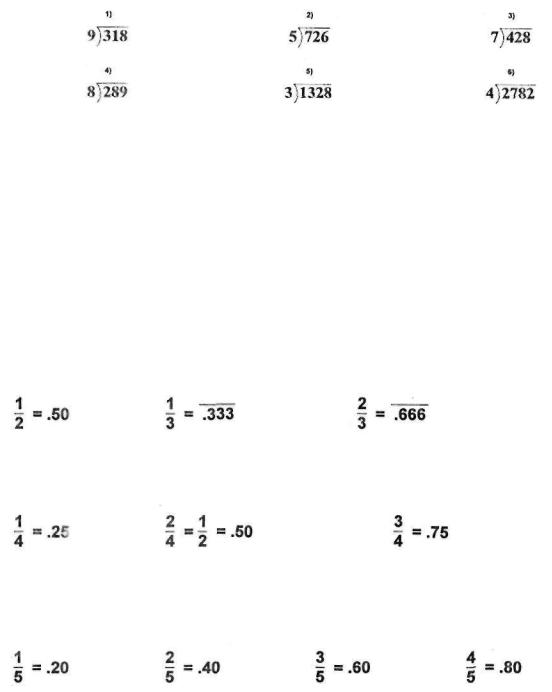
Exercises: 1-Digit. Division
DECIMALIZATION
As you might guess, I like to work some magic when I convert fractions to decimals. In the case of 1-digit fractions, the best way is to commit the following fractions—from halves through elevenths—to memory. This isn't as hard as it sounds. As you'll see below, most 1-digit fractions have special properties that make them hard to forget. Anytime you can reduce a fraction to one you already know, you'll speed up the process.
Chances are you already know the decimal equivalent of the following fractions:
(The bar signifies that the numbers will repeat indefinitely.)
Likewise:
The fifths are easy to remember:
38
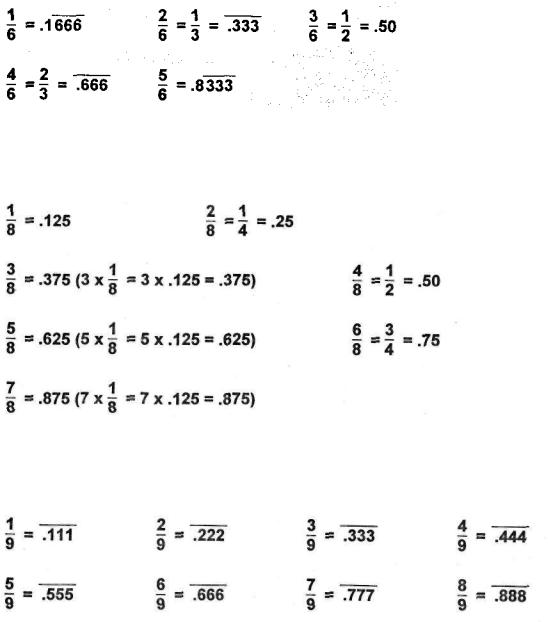
The 6ths require memorizing only two new answers:
I'll return to the 7ths in a moment. The 8ths are a breeze:
The 9ths have a magic all their own:
39
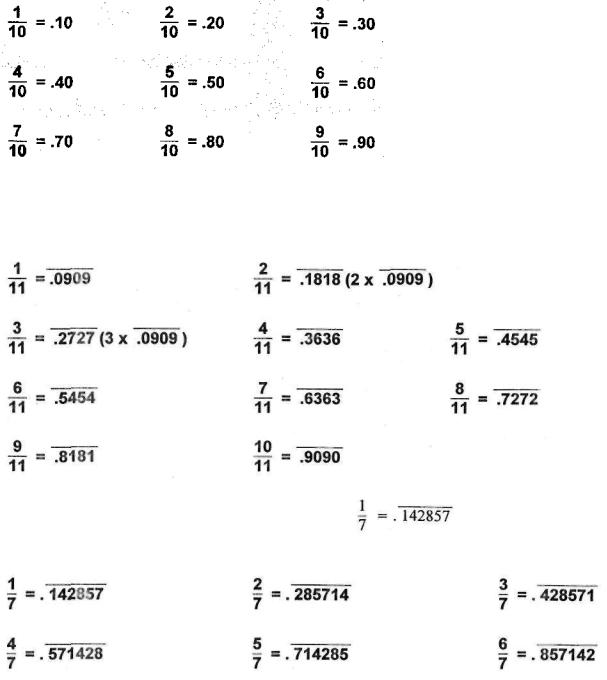
The 10ths you already know:
For the 11 ths, if you remember that  = .0909, the rest is easy:
= .0909, the rest is easy:
The 7ths are truly remarkable. Once |
you memorize |
, you can get all the |
other 7ths without having to compute |
them: |
|
40
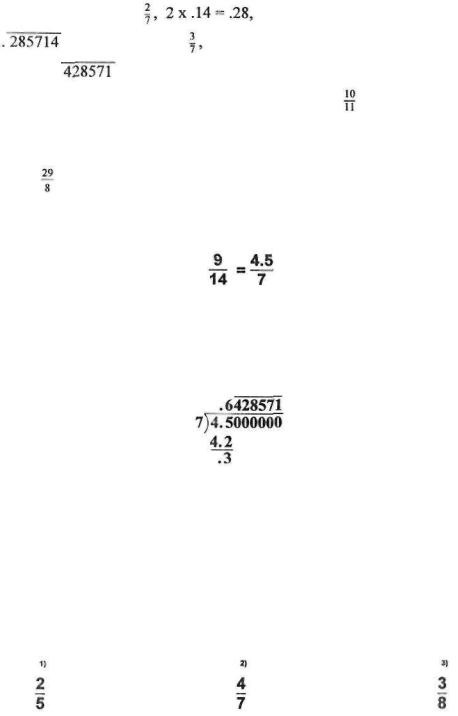
Note that the same pattern of numbers repeats itself in each fraction. Only the starting point varies. You can figure out the starting point in a flash by multiplying .14 by
the numerator. In the case of |
so use the sequence that begins with the 2, |
||
namely |
. Likewise with |
since 3 x .14 = .42, |
use the sequence that begins |
with 4, namely . |
. Likewise the rest. |
|
|
You will |
have to calculate |
fractions higher than |
as you would any other |
division problem. However, keep your eyes peeled for ways of simplifying such
problems. For example, you can simplify the fraction  by dividing both numbers by 2,
by dividing both numbers by 2,
to reduce it to , which is easier to compute.
If the denominator of the fraction is an even number, you can simplify the fraction by reducing it in half, even if the numerator is odd. For example:
Dividing the numerator and denominator in half reduces it to a 7ths fraction. Although the 7ths sequence previously shown doesn't provide the decimal for  once you begin the calculation, the number you memorized will pop up:
once you begin the calculation, the number you memorized will pop up:
As you can see, you needn't work out the entire problem. Once you've reduced it to dividing 3 by 7, you can make a great impression on an audience by rattling off this long string of numbers almost instantly!
Exercises: Decimalization
To solve the following problems, don't forget to employ the various 1-digit fractions you already know as decimals. Wherever appropriate, simplify the fraction before converting it to a decimal.
41
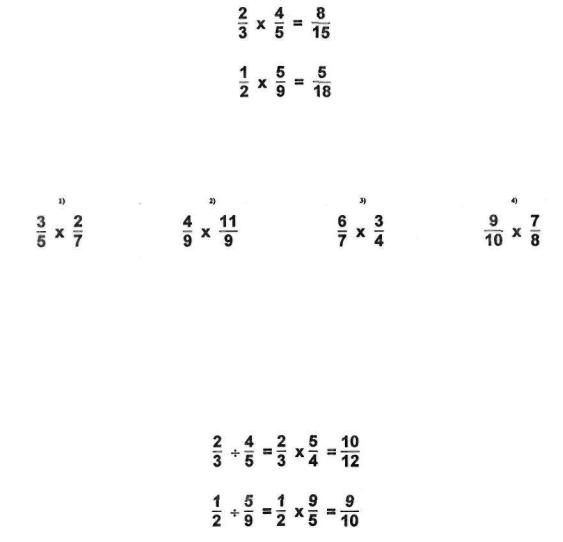
FRACTIONS
If you can manipulate whole numbers, then doing arithmetic with fractions is almost as easy. In this section, we review the basic methods for adding, subtracting, multiplying, dividing, and simplifying fractions. Those already familiar with fractions can skip this section with no loss of continuity.
Multiplying Fractions
To multiply two fractions, simply multiply the top numbers (called the numerators), then multiply the bottom numbers (called the denominators). For example,
What could be simpler! Try these exercises before going further.
Exercises: Multiplying Fractions
Dividing Fractions
Dividing fractions is just as easy as multiplying fractions. There's just one extra step. First, turn the second fraction upside down (this is called the reciprocal) then multiply. For instance, the reciprocal of  Therefore,
Therefore,
42
